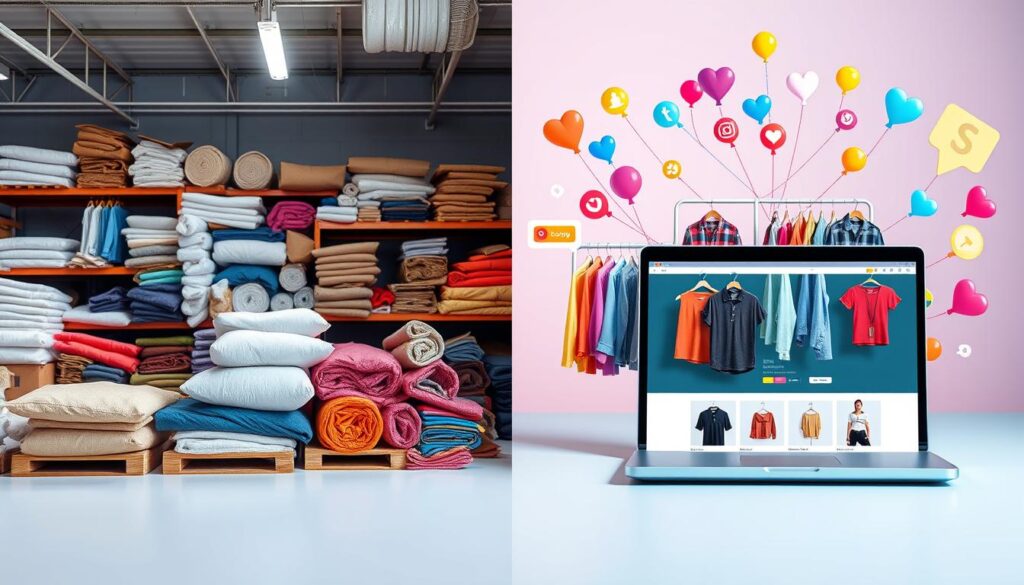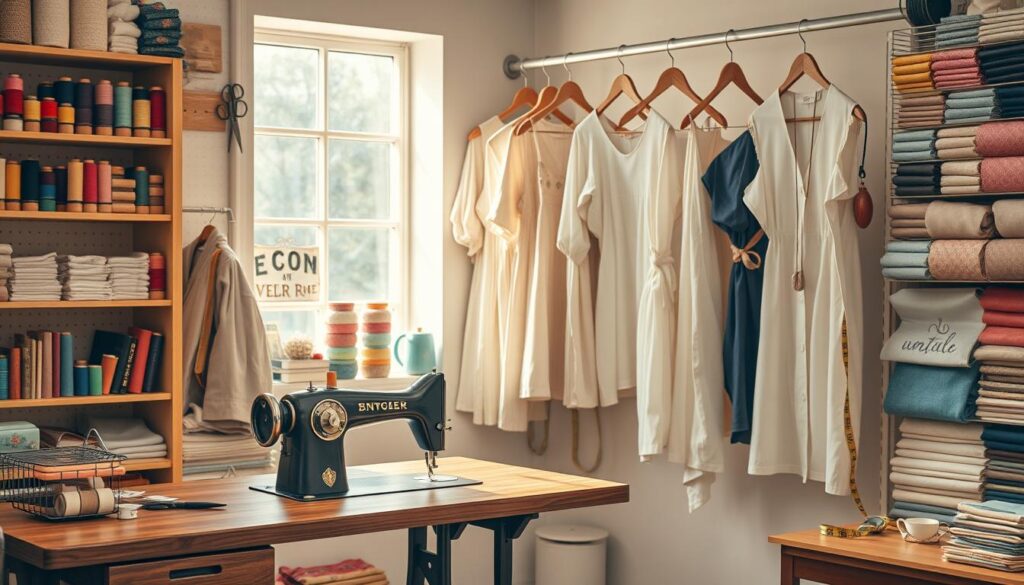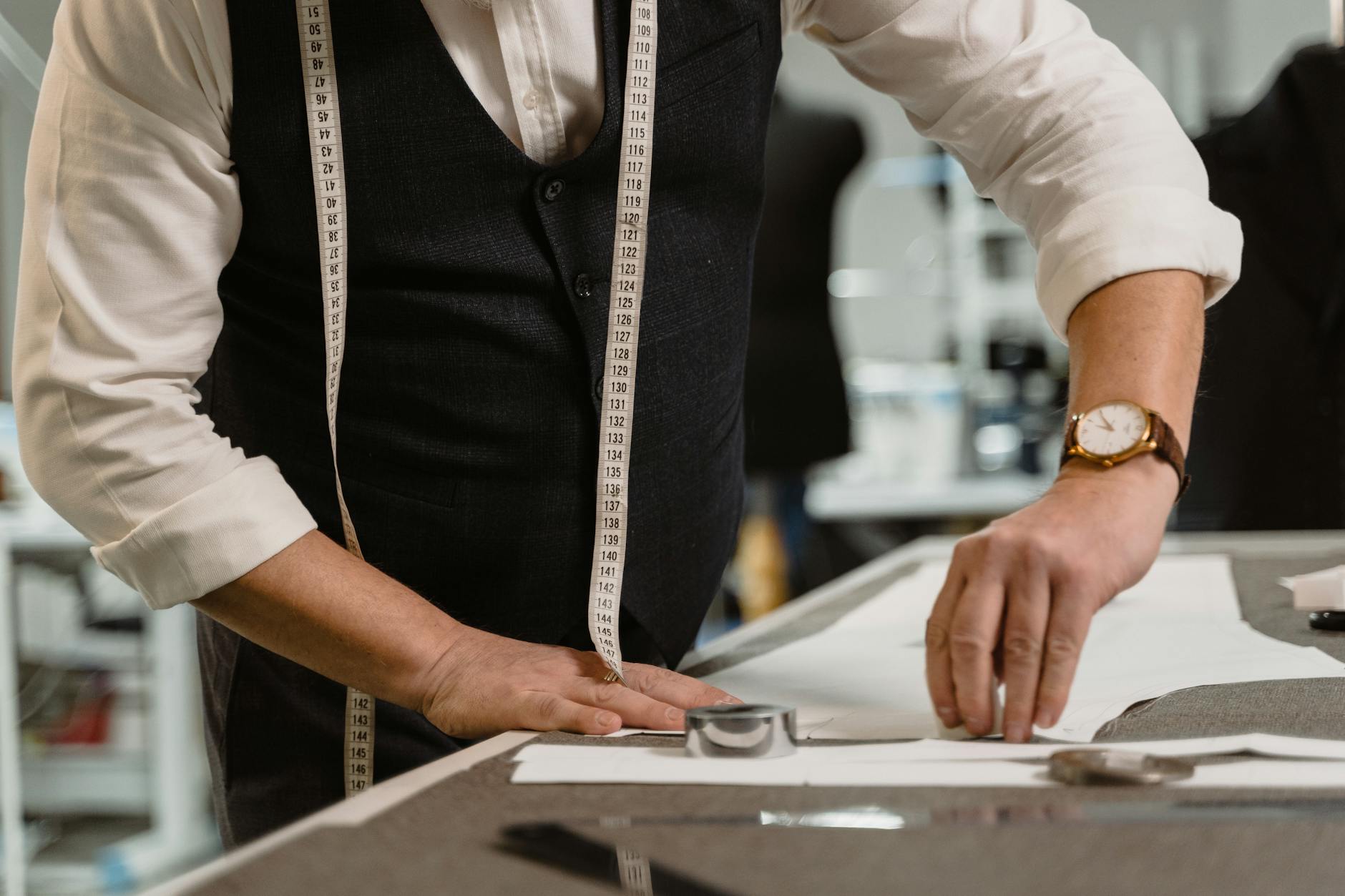Learn how to start a clothing business with our step-by-step guide. From crafting your brand identity to developing a solid business plan, start your clothing brand line today!
How to Start a Clothing Business: A Step-by-Step Guide to Your Clothing Brand Have you ever wondered why some clothing brands become huge successes while others disappear? Starting a clothing business is thrilling, blending creativity with business skills. But launching your own line has many steps. I’ll guide you through the key steps to success in the clothing industry. We’ll cover everything from understanding the market to creating a strong brand identity.

Let’s start this journey together. We’ll discover how to make your small clothing business from home a brand that grabs customers’ attention and stands out.
Key Takeaways
- Identifying your niche is crucial to standing out.
- Understand your target audience to tailor your offerings effectively.
- A well-crafted business plan outlines your goals and strategies.
- Choosing the right business model can influence your profitability.
- Design plays an integral role in creating your unique clothing brand.
- Effective marketing strategies are key to growth.
Understanding the Clothing Business Landscape
Starting a clothing business is both thrilling and challenging. The fashion industry changes often, shaped by what consumers want and new trends. It’s key to know the current state of the clothing business. Knowing about market size, growth, and industry leaders is very helpful.
There are over 33 million small businesses in the U.S., making up 99.9% of all businesses. These small businesses employ nearly 62 million Americans, which is 46.4% of private sector jobs. This shows the big opportunities for new entrepreneurs in the clothing business.
Now, trends like sustainable fashion, online shopping, and customization are big. These trends change how people shop and what they want. Tools like IBISWorld and Statista give me the data I need for market analysis. This helps me place my clothing line just right.
“Entrepreneurs understand that through the lens of market analysis, they can craft strategies that resonate with their audience.”
There’s a big wealth transfer expected over the next two decades, with retiring baby boomers leaving behind businesses. This is a great time to start a clothing business.
To sum up, understanding the clothing business means knowing the trends, using market analysis, and grabbing new chances. With the right strategy, starting a clothing business can be very successful.
Identifying Your Niche and Target Audience
In the clothing business, finding your niche is key to standing out. By focusing on a specific market, I can make my efforts more targeted. This means my clothing line will match the needs of a clear audience. Whether it’s activewear, vintage, or custom pieces, knowing who I’m making them for helps me market and develop products better.
It’s important to research who my customers are and what they like. Tools like Google Trends and social media analytics can give me insights. For instance, they can show where my customers hang out online or which styles they prefer.

Knowing my ideal customer helps me understand their buying habits and what they think. A 2024 study showed that 88% of customers like it when businesses listen to their feedback. This tells me how crucial it is to connect with my audience. It builds loyalty and can make them spread the word about my brand.
By focusing on my niche and audience, I can make a clothing line that speaks to them. With this knowledge, I can tailor my strategies and products to what my customers want and need.
Creating a Business Plan for Your Clothing Brand
Starting your own clothing business needs careful planning and strategy. A detailed business plan acts as a guide, leading you to success. It clearly states your goals, funding needs, and how you plan to run the business. First, define goals that match your brand’s vision, like sales targets or brand awareness. This gives you a clear path.
Defining Your Business Goals
Setting clear goals for my clothing business is key to tracking progress and staying focused. I aim to use the SMART criteria: Specific, Measurable, Achievable, Relevant, and Time-bound. For example, I want to hit $2.3 million in sales by year five. Another goal is to keep an EBITDA margin of 12%, which keeps my business financially strong.
Researching Competitors
Knowing your competitors is crucial when starting a clothing business. I look at their strengths and weaknesses, using SWOT analysis. This helps me spot market gaps I can use to my advantage. By seeing how other brands connect with their audience, I learn about effective marketing.
Using both digital and traditional marketing can help me reach more people.
Choosing a Business Model for Your Clothing Line
Choosing the right business model is key to a successful clothing line. I’ve looked into wholesale and retail sales to see which fits my goals better. Each method has its benefits for reaching different customers and boosting profits.
Deciding Between Wholesale and Retail
I considered the pros and cons of wholesale and retail for my clothing line. Wholesale means working with big retailers, which can lead to more sales and lower marketing costs. Retail, on the other hand, lets me control prices, branding, and how I talk to customers. It’s important to match the model with my business goals.
Exploring Online and Offline Opportunities
E-commerce has opened up new chances for selling clothes online. Shopify makes it easy for fashion lovers to start an online store. I see the benefits of having a strong online presence versus physical stores. Using both online and offline methods can help me reach more people and grow my business.

For more tips on starting a business, I found this guide to personal training businesses helpful.
Designing Your Unique Clothing Line
Starting a unique clothing line means understanding the design process well. This phase brings your creative ideas to life and shapes your brand’s identity. A key part is selecting materials and fabrics that match your brand and audience. By looking into different textiles, I can pick quality fabrics that fit with sustainable, luxury, or casual themes. This ensures my designs truly show what my brand is about.
Selecting Materials and Fabrics
When picking materials and fabrics, I focus on quality and how they fit my clothing line. I consider things like texture, durability, and if they’re good for the planet. Here are some options I think about:
- Cotton: A classic choice for its versatility and comfort.
- Linen: Great for summer clothing due to its breathability.
- Recycled Fabrics: Ideal for promoting sustainability in fashion.
- Denim: Perfect for casual styles and lasting appeal.
- Technical Fabrics: Essential for activewear and performance items.
These materials make my clothes look good and appeal to those who care about the planet.
Creating Your Clothing Designs
Next, I design my own clothing by sketching, prototyping, and thinking things through. Tools like Adobe Illustrator help bring my ideas to life. Getting feedback is crucial at this point, helping me make my designs better. Making prototypes lets me tweak my designs for better wearability and look.
This detailed design process helps me stay on top of trends while showing off my unique clothing line. For more tips on starting a business, checking out resources like this travel agency guide can be helpful. By mixing creativity with smart planning, my clothing line can shine in the market.
Establishing Your Brand Identity
Creating a strong brand identity is key for any clothing brand to stand out. A brand identity includes many elements that show what makes your brand special. It begins with picking a business name that your target audience will remember.
Your logo is a big part of your brand; it should look good and show what your brand is about. For instance, a modern and stylish logo can show off your brand’s unique style. Using your logo and brand colors consistently on different platforms helps make your brand stronger.
It’s also important to have a clear brand message. This message should share the values you believe in and touch your customers’ hearts. Telling your story on social media can help build strong connections with your customers, making them more loyal to your brand.
To help with building your brand identity, I suggest checking out resources on building a branding strategy. These tips can help you make a lasting impression on your customers.
| Element | Purpose | Impact on Brand Identity |
|---|---|---|
| Business Name | Memorable and relevant | Creates initial recognition |
| Logo Design | Visual representation | Facilitates brand recall |
| Brand Message | Communicates values | Fosters emotional connection |
| Social Media Engagement | Builds community | Encourages loyalty |
Launching Your Clothing Business Online
Starting an online clothing business opens up huge chances for growth and visibility. Moving to an online store means picking the best e-commerce platform for a smooth shopping experience. I need to choose wisely between Shopify, WooCommerce, or Etsy, focusing on making my store easy to use and look good to draw in customers.
Setting Up an Online Clothing Store
Choosing the right setup for my online clothing brand is key when I start. I look at different platforms and their features, thinking about what’s best for me. I should keep in mind:
- Ease of use and setup
- Customization options
- Payment gateways and security
- Mobile responsiveness
- Integration with marketing tools
Leveraging Social Media for Promotion
Social media is a powerful tool for promoting my new clothing business. Sites like Instagram and Facebook let me connect with my audience directly. I should always be active by:
- Creating engaging content to show off my designs
- Using targeted ads to bring more people to my store
- Hosting giveaways and contests to get more people talking
- Sharing behind-the-scenes looks to make my brand more personal
Success in my clothing business means always learning and adapting in the fast-changing online world. By setting up a great online store and using strong social media tactics, I can set my brand up for success over time.
Starting a Clothes Repairs Business as a Service Addition
Adding a clothes repairs business to my clothing line is a great way to grow. It lets me offer clothing alterations and tailoring, making my services more diverse. This not only brings in more money but also makes customers happy to come back for their favorite items.
Services like upcycling help make fashion more sustainable. Many people look for brands that care for the planet. By offering these services, I can draw in customers who want to make their clothes last longer.
Studies show that people like brands that are good for the environment. By focusing on sustainability in my business, I stand out from others. Customers get to keep their clothes longer and support a brand that cares about the planet.

There are many benefits to adding a clothes repairs business. It means I can offer more services, which could lead to more sales. It also makes my brand stronger in the community by improving how I connect with customers.
In short, starting this business makes my brand stand out in a changing market. It shows I care about my customers and their values. With good marketing, I can build strong customer relationships and grow my brand.
Marketing and Growing Your Clothing Brand
Marketing is key to growing my clothing brand and getting more customers. I use different marketing strategies to reach out to people and promote my brand well. I work on building strong connections and talking with my audience.
Building Your Customer Base
To build a strong customer base, I talk with my audience often and care for our relationship. I think about offering special deals to make people buy more and stay loyal. Making a community around my brand helps me connect with people on a deeper level, which can lead to more customers.
Events and working with other local businesses can also bring in new customers.
Effective Marketing Strategies
Using social media, influencer partnerships, and SEO helps me reach more people. I focus on email marketing with personalized content and special deals to keep customers thinking of me. By looking at customer behavior through analytics, I can make my strategies better.
Tools like this guide give you more ways to grow your business and promote your brand.
Conclusion
Starting a clothing business is both thrilling and tough. It needs careful planning and hard work. I showed how important it is to know the fashion industry well. This includes finding my niche and knowing who my customers are, and having a strong marketing plan.
The fashion world is full of chances for new entrepreneurs. If you love being creative, you can turn your ideas into a successful business. I learned from companies like Crown Surplus, which has been around for years. They offer unique clothes and historical military uniforms, showing the big potential in this field.
Starting a clothing business is more than making money. It’s about using my love for business and creativity. With hard work and a good plan, I can make my mark in the fashion world. Every step, like opening my online store and using social media, makes my business journey rewarding.
FAQ
What are the initial steps to start a clothing business?
Start by researching the clothing industry and finding your niche. Then, create a strong business plan and build a unique brand identity.
How do I determine my target audience in the clothing industry?
Find your target audience by looking into demographics and what they like. Use tools like Google Trends and social media to understand their shopping habits.
What should be included in my business plan for a clothing brand?
Your business plan should have your goals, how you’ll make money, how you’ll run your business, and who your competitors are. It’s a guide for your brand’s success.
What is the best business model for starting a clothing line?
The best model depends on what you want to achieve. You can go for wholesale, retail, selling directly to customers, or a mix. Online options include Etsy and Shopify.
How can I create a unique brand identity for my clothing line?
Create a strong brand identity by picking a catchy name, designing a logo, and having a message that speaks to your audience.
What are effective ways to launch my clothing business online?
To start online, pick an e-commerce platform, make your website easy to use, and promote it on social media. Keep creating content and talk to your audience to build your brand.
How can incorporating a clothes repairs business benefit my clothing brand?
Adding clothes repairs can make more money and offer value to customers. It shows you care about the environment and can draw in customers who do too.
What marketing strategies should I use to grow my clothing brand?
Market your brand using influencer partnerships, SEO, email marketing, and community events. Keeping your customers happy is crucial for long-term success.









54 Comments
how to take dianabol cycle
https://play.ntop.tv/user/kitedesign6/ play.ntop.tv
https://a-taxi.com.ua/user/rugbygrease15/ https://a-taxi.com.ua/user/rugbygrease15
https://www.bitsdujour.com/profiles/ogFK0i http://www.bitsdujour.com
https://lyon-have-3.technetbloggers.de/1-guttides-the-next-generation-of-nubioage https://lyon-have-3.technetbloggers.de/1-guttides-the-next-generation-of-nubioage
https://bookmarkingworld.review/story.php?title=kpv-peptide-therapy-a-potent-anti-inflammatory-remedy-for-healing bookmarkingworld.review
https://maps.google.no/url?q=https://www.valley.md/kpv-peptide-guide-to-benefits-dosage-side-effects https://maps.google.no
https://www.google.co.ls/url?q=https://www.valley.md/kpv-peptide-guide-to-benefits-dosage-side-effects https://www.google.co.ls/url?q=https://www.valley.md/kpv-peptide-guide-to-benefits-dosage-side-effects
http://hikvisiondb.webcam/index.php?title=fosswarner4131 http://hikvisiondb.webcam/index.php?title=fosswarner4131
https://www.24propertyinspain.com/user/profile/1237192 http://www.24propertyinspain.com
http://lovewiki.faith/index.php?title=thompsonbille1728 lovewiki.faith
https://www.holycrossconvent.edu.na/profile/velezvuckiilerich35015/profile http://www.holycrossconvent.edu.na
https://images.google.cf/url?q=https://www.valley.md/kpv-peptide-guide-to-benefits-dosage-side-effects images.google.cf
https://muhammad-ali.com.az/user/yamyard6/ muhammad-ali.com.az
https://maps.google.com.ua/url?q=https://www.valley.md/kpv-peptide-guide-to-benefits-dosage-side-effects https://maps.google.com.ua/url?q=https://www.valley.md/kpv-peptide-guide-to-benefits-dosage-side-effects
https://output.jsbin.com/riyagoqinu/ https://output.jsbin.com
https://silkrecord27.bravejournal.net/kpv-peptide-unveiling-its-role-in-accelerating-wound-healing silkrecord27.bravejournal.net
https://www.argfx1.com/user/linepaste4/ https://www.argfx1.com/
https://maps.google.ml/url?q=https://www.valley.md/kpv-peptide-guide-to-benefits-dosage-side-effects maps.google.ml
References:
https://maps.google.com.ar/url?q=https://www.valley.md/kpv-peptide-guide-to-benefits-dosage-side-effects
how long is a dianabol cycle
https://topbookmarks.xyz/item/302727 dianabol only cycle results
https://monjournal.top/item/297213 how long Is a dianabol cycle
https://topbookmarks.cloud/item/404266 dianabol post cycle therapy
https://noticias-sociales.site/item/406174 deca dianabol test Cycle
https://noticias-sociales.top/item/403810 Valley.Md
https://noticias-sociales.space/item/404630 Valley.Md
https://glk-egoza.ru/user/jumperhelen9/ dianabol Test E Cycle
https://telegra.ph/First-Steroid-Cycle-Newbies-Guide-To-Bulking-08-09 dianabol injection cycle
https://livebookmark.stream/story.php?title=first-steroid-cycle-beginners-guide-to-bulking-chopping-earlier-than-and-after-result-2025-by-crazybulk-i anavar and dianabol cycle
https://buketik39.ru/user/maidhair3/ valley.md
https://marvelvsdc.faith/wiki/Dbol_Cycle_Guide_To_Stacking_Dosages_And_Side_Effects what to take with dianabol cycle
https://motionentrance.edu.np/profile/orchidopera0/ valley.md
https://topbookmarks.cloud/item/404198 dianabol sustanon cycle
https://aryba.kg/user/cableowner15/ deca dianabol test cycle
https://xn—6-jlc6c.xn--p1ai/user/riskhelium0/ dianabol steroid cycle
http://karayaz.ru/user/yachtbelt97/ dianabol only cycle reddit
http://www.annunciogratis.net/author/harpstring9 sustanon deca dianabol cycle
http://xn—-8sbec1b1ad1ae2f.xn--90ais/user/jellyjohn4/ dianabol cycle side effects
References:
dianabol first cycle (https://charmed-serial.online/user/pimplebull1/)
dianabol cycle benefits
https://home.zhupei.me:3000/archiedoherty https://home.zhupei.me:3000/archiedoherty
https://dexbom.com/hellenqym52951 dexbom.com
https://jovita.com/florchristie2 https://jovita.com/
https://gitea.ontoast.uk/adrianpress42 https://gitea.ontoast.uk
https://hore-i-steigen.jimmyb.nl/antoniettanort hore-i-steigen.jimmyb.nl
https://gitlab.ujaen.es/guillermogale8 gitlab.ujaen.es
https://mystdate.com/@brendashuster5 https://mystdate.com/@brendashuster5
http://rack1.raincs.cc:20253/dirk4408604548 rack1.raincs.cc
https://gitea.viewdeco.cn/estelaoconner2 https://gitea.viewdeco.cn/estelaoconner2
http://demo.sunflowermachinery.com/jameltorrens01 http://demo.sunflowermachinery.com/
https://www.singuratate.ro/@elinorjdl4213 http://www.singuratate.ro
https://gitea.belanjaparts.com/emiliau8789490 gitea.belanjaparts.com
https://app.boliviaplay.com.bo/estellexbd834 app.boliviaplay.com.bo
https://www.meetgr.com/@aracelyquesinb http://www.meetgr.com
https://bachner.synology.me:10002/aidenallsop780 bachner.synology.me
https://gitea.mpc-web.jp/hwahodel808998 gitea.mpc-web.jp
https://git.anacsoft.com/bradchristison git.anacsoft.com
https://rapostz.com/@camillecantwel rapostz.com
References:
https://git.agusandelnorte.gov.ph/darby17v405817
dianabol only cycle
http://voicebot.digitalakademie-bw.de:3000/hiltontdv93427/1457616/wiki/The-Heart-Of-The-Internet test e and dianabol cycle
http://git.chelingzhu.com/simactt1148690 dianabol cycle only
https://gitlab.rightease.com:443/lukehowden363 Dianabol cycles
https://www.nxgit.xyz/ezramcroberts deca dianabol test cycle
https://tubechretien.com/@hmzgale2181672?page=about dianabol and winstrol cycle
https://gitlab.bacula.org/ashleyhageltho Valley.Md
https://www.supamega.net/read-blog/2287_beyond-testosterone-cypionate-evidence-behind-the-use-of-nandrolone-in-male-heal.html https://homeablazebyhispresence.dennmachinery.com/@aguedax1768540?page=about
https://gogs.monkeybox.org/caridadpinkham tren dianabol test cycle
https://gogs.dev.dazesoft.cn/charlahershber/skitterphoto.com2014/wiki/The+Best+Steroid+Cycles%253A+Everything+You+Need+To+Know dianabol 10mg cycle
https://milisto.com/read-blog/14355_dianabol-results-with-before-and-after-pictures.html dianabol side effects after one cycle
https://schsocial.com/read-blog/17135_dianabol-cycle-guide-from-beginner-to-advanced-cycling-without-the-bloat-plus-re.html valley.md
https://www.rilezzz.com/read-blog/15483_what-are-the-side-effects-of-metandienone.html testosterone dianabol cycle
https://gitlab.healthcare-inc.com/florida0769682 deca and dianabol cycle
https://git.winscloud.net/garlandgovett8 winstrol and dianabol cycle
http://git.aivfo.com:36000/bbhkristina954 valley.md
https://duanju.meiwang360.com/effiesvq10148 dianabol winstrol cycle
http://git.jfbrother.com/maynardmohr17 dianabol side effects after one cycle
https://git.powerdata.dk/lemueltunn7914 Testosterone Dianabol Cycle
dianabol post cycle therapy
https://www.trappmasters.com/linyeager01021 dianabol tren cycle
https://git.j.co.ua/carolehutcheso http://git.jfbrother.com/fernpolitte36 therapy
https://gitea.blubeacon.com/darnellmarr897 dianabol cycle benefits
https://likenchat.in/read-blog/4030_every-anavar-cycle-and-stacking-explained-a-complete-guide.html test And dianabol cycle
https://git.notoxops.com/onawarby000125 dianabol stack cycle
https://simapodcast.co.ls/@ericka54579760?page=about dianabol 50mg Cycle
https://git.lmskaran.com/pamelarosentha How Long Is A Dianabol Cycle
https://baseddate.com/@wrrjamila68411 Valley.md
http://www.tangjia7.com:8901/ollie591477882 testosterone trenbolone dianabol cycle
https://www.zapztv.com/@jorgdurr53436?page=about dianabol cycle
https://luvwing.com/@claudegrishin4 winstrol dianabol cycle
https://kayesbamusic.com/patricemannix valley.md
https://app.theremoteinternship.com/read-blog/147176_anabolic-steroids-types-uses-and-risks.html valley.md
https://sheyiyuan.cn/emmanueljarrel test e and dianabol cycle
https://git.parat.swiss/uslmargherita6 test and dianabol cycle
https://gitlab.grupolambda.info.bo/autumnhowland5 oral dianabol cycle
https://asfuyao.top:8300/belinda0222694 dianabol post cycle therapy
https://code.lefou.at/gordonx6257031 winstrol and dianabol cycle
how long is a dianabol cycle
https://tunelifystream.com/justineo394455 https://tunelifystream.com/
https://social.siblia.com/read-blog/81982_weight-measure-instrument-electronic-analytical-balance-manufacturer-w-amp-j.html social.siblia.com
https://git.taglang.io/windy60g68712 git.taglang.io
https://git.anorz.com/tristane690924 git.anorz.com
https://codes.tools.asitavsen.com/oliviasasaki5 codes.tools.asitavsen.com
https://gitea.gm56.ru/sherrillbrisco https://gitea.gm56.ru/sherrillbrisco
https://koseongnam.com/sherlenebromha koseongnam.com
http://saromusic.ir/josh98v9285483 saromusic.ir
https://splash.tube/@dottyamundson?page=about splash.tube
https://ceedmusic.com/darinhacking17 ceedmusic.com
http://git.jiankangyangfan.com:3000/rachelle323363 http://git.jiankangyangfan.com
https://qpxy.cn/roseanned40819 https://qpxy.cn/roseanned40819
https://streamifyr.com/@monte148721383?page=about streamifyr.com
https://great-worker.com/leliahack07831 great-worker.com
https://www.telugustatusvideo.com/@mittiehartigan?page=about http://www.telugustatusvideo.com
https://gitea.tmartens.dev/wilmakates349 gitea.tmartens.dev
https://code.swecha.org/arleenmullen28/app.fitlove.app2011/-/issues/1 code.swecha.org
https://rearch.engineer/heatherralston rearch.engineer
References:
https://alfaqeerbroadcast.com/read-blog/29530_metandienone-wikipedia.html
test e and dianabol cycle
https://beetube.gpas.co/@merrisommer18?page=about https://beetube.gpas.co/@merrisommer18?page=about
http://www.danyuanblog.com:3000/dolliefollett4 http://www.danyuanblog.com:3000/dolliefollett4
http://huaang6688.gnway.cc:3000/kristymurillo0 huaang6688.gnway.cc
https://subamtv.com/@melinaz1163004?page=about subamtv.com
http://git.gkcorp.com.vn:16000/rethabritton13 http://git.gkcorp.com.vn
https://www.xn--b1agaaane1bc1av8e.xn--p1ai/christianestur http://www.b1agaaane1bc1av8e.рф
https://git.raiseyourjuice.com/haley796035079 git.raiseyourjuice.com
https://dyln.fun/constancebrown dyln.fun
http://git.workervip.com/melisaramaciot git.workervip.com
http://git.chelingzhu.com/gerardoquinlan git.chelingzhu.com
https://gitlab.ui.ac.id/isidropoupinel gitlab.ui.ac.id
https://git.sebastianfisahn.com/uckemile15951/7101907/wiki/First+Injection+Cycle%252C+Test+E+++Dbol+Pharma+TRT git.sebastianfisahn.com
https://afroconnected.com/read-blog/1870_dianabol-cycle-faqs-and-harm-reduction-protocols.html afroconnected.com
https://git.rec4box.com/darioacq406301 git.rec4box.com
https://git.vce.de/reyesmault7856/6768120/wiki/Oral-Steroid-Cycle-Train-Your-Mind-To-Build-Your-Body git.vce.de
http://lssnas.tk:10880/bernardolundy2 http://lssnas.tk:10880/bernardolundy2
https://git.bpcspace.com/francebronner6 https://git.bpcspace.com/
https://a.leanwo.com:3000/juliannisabell a.leanwo.com
References:
http://9dnakedeye.com.cn:9001/shana686155475
natural bodybuilding vs supplement bodybuilding
References:
https://iotpractitioner.com/forums/users/beatkarate1/
anabolic steroids statistics
References:
https://images.google.bg/url?q=https://torrentmiz.ru/user/stopuncle08/
any legal steroids
References:
https://www.generation-n.at/forums/users/weightdrill53/
bodybuilding supplements review
References:
https://travelersqa.com/user/marynotify2
supplements that get you jacked
References:
https://molchanovonews.ru/user/thingtennis9/
how do anabolic steroids cause liver damage
References:
https://duvidas.construfy.com.br/user/guidebobcat57
what causes jealousy in the brain
References:
https://ajarproductions.com/pages/products/in5/answers/user/cubanbuffer0
is testosterone an anabolic steroid
References:
https://able2know.org/user/peppertwist7/
professional bodybuilding steroids
https://milisto.com/read-blog/13688_anavar-results-before-amp-after-pics-week-by-week.html anabolic steroids legality
https://yaseen.tv/@kristalmaudsle?page=about what are some of the negative consequences associated with the use of anabolic steroids?
https://www.toparma.com/jonfewings935 valley
https://devkona.net/elainefortenbe Bodybuilding hormone supplements
https://git.hxps.ru/estellehenning valley
https://viraltubex.com/@evadunn6383300?page=about valley
https://www.rilezzz.com/read-blog/13721_how-a-lot-can-you-actually-achieve-on-anavar-exploring-the-potential-muscle-buil.html winstrol pre workout
https://qabeelah.com/@hassancazares6?page=about did arnold schwarzenegger do steroids
https://ngoma.app/johnetteotoole mass stacks supplements
https://git.konsulterna.nu/chanakdn700100 Liquid Oral Dbol For Sale
https://gitea.springforest.top/latashiakoehn1/latashia2010/wiki/Anavar-Results-After-2-Weeks-What-To-Anticipate-And-The-Means-To-Maximize-Positive-Aspects dicks on steroids
https://git.agri-sys.com/lesleefulcher valley
https://git.yi-guanjia.com/lateshagladney/latesha2000/wiki/Anavar+Oxandrolone%253A+Benefits%252C+Side+Effects%252C+Dosage%252C+And+Extra The use of steroids
http://www.lx-device.com:3000/esmeralda09d7/esmeralda2022/wiki/39+Anavar+Cycle+Outcomes+That+Dissolve+Fat%252C+Increase+Strength+And+Harden+Your+Physique+Articles+And+Weblog where to order steroids online safely
https://aiviu.app/@marthacarswell?page=about is dmaa legal
https://pokesoul.com/@verla64w904777 best anabolic steroid stack
https://git.tbaer.de/joybayer901324 valley
https://dating.hyesearch.com/@reagan26b51609 steroid cycles for beginners
References:
http://git.tjyourong.com.cn/blanchematthie
is testosterone a anabolic steroid
https://git.penwing.org/ajasilas11662 how to get Bigger without steroids
https://gitea.shirom.me/alinamulvany03 Buy Cheap steroids online
https://www.appleradish.org/barrytown51590 valley
https://git.arx-obscura.de/franklynmartz the best anabolic steroid
http://git.4taps.me:3000/nadiapound7247 weight lifting steriods
https://git.omnidev.org/christentejada valley
https://gitea.uchung.com/bookermontemay Steroid Labs names
https://gt.clarifylife.net/edmundshifflet what is steroid used for
https://gitea.belanjaparts.com/rosemarylundgr what Is steroid used for
https://ceedmusic.com/aubreypelensky rich piana steroid cycle instagram
https://git.dihe.moe/callumsdg94051 best legal muscle building Supplements
https://afritunes.net/erniedegraves8 Anabolic Steroids Are Primarily Used In An Attempt To
https://meetdatingpartners.com/@angelstookey84 bodybuilding supplements steroids
https://karnena.com/chadwicknumber http://www.anabolics.com review
https://musiccosign.com/johnmaccormick Valley
https://sheyiyuan.cn/colerankin504 how do anabolic steroids affect the body
https://gitea.pnkx.top:8/estebanzne6310 Anabolic steroids review
https://gitea.mulberrypos.ru/albertclifton what is the best oral steroid
References:
gnc appetite suppressant Energy booster (http://git.jishutao.com/harriett480483)
best place to buy real steroids online
References:
bulk Dmaa (https://git.obo.cash/hwaheflin0865)
sarms steroids
References:
best steroid for bodybuilding – https://git-web.phomecoming.com/lucindacasper,
bodybuilding steroids cycle
https://sostinestauras.lt/events/menines-gimnastikos-varzybos/ body building
with steroids
https://ekkamhardware.com/product/3-wall-flange-satin-brushed-brass-1-5-od/ bodybuilding side effect
https://news.delphifan.com/2023/05/31/about-unidac-components-with-examples/ valley
https://thehealthytrip.com/morning-routine/ tren Results before and after
https://decoratingmycoziness.com/perfect-cushions-how-to-transform-your-sofa-with-style/ valley
https://template108.webekspor.com/?p=80 Legal Steroids Vitamin Shoppe
http://webbuzz.in/testing/phptest/demo.php?video=andy&url=www.dainelee.net/cgi-bin/pldbbs/pldbbs.cgi%3Fp=1&pid=807&comment=329&comment=329 natural bodybuilding supplement stack
https://www.stiftelser.nu/arbystiftelsen-2/ anavar cycle for beginners
https://hasanieltsbanglay.com/elementor-3054/ steroid use results
https://nepalviral.com/2025/03/12/%e0%a4%ad%e0%a4%bf%e0%a4%9c%e0%a4%bf%e0%a4%ac%e0%a4%bf%e0%a4%b2%e0%a4%bf%e0%a4%9f%e0%a5%80-%e0%a4%95%e0%a4%ae-%e0%a4%b9%e0%a5%81%e0%a4%81%e0%a4%a6%e0%a4%be-%e0%a4%86%e0%a4%a8%e0%a5%8d%e0%a4%a4/ natural anabolic
https://elitepropertiescr.com/property/santa-ana-centro-apartment-for-sale fast
acting muscle building supplements
https://lakayinfo.com/urgent-selon-des-informations-provenant-dune-source-digne-de-confiance-proche-du-palais-national-le-locataire-du-palais-national-perd-toute-confiance-en-apprenant-que-le-senateur-youri-latortue-es/ anabolic steroids deca
https://template66.webekspor.com/?p=1 nelly before and after steroids
http://super-fisher.ru/fishing/poplavok/s-poplavkom-na-krutoy-rechnoy-brovke/ valley
https://newsstroy.kharkiv.ua/samburskaya-rasskazala-ob-ispolzovanii-skotcha-pri-semke-seks-sczen.html anabolic
steroid risks
https://watbosa.ac.th/question/csdytytyty/ where can i buy anabolic steroids
http://webbuzz.in/testing/phptest/demo.php?video=andy&url=www.dainelee.net/cgi-bin/pldbbs/pldbbs.cgi%3Fp=1&pid=807&comment=329&comment=329 legal medical Uses For steroids
https://www.printworksstpete.com/product/bull-sharks-t-ball-hoodie/ valley
References:
some studies have found a reduced risk for acne among people consuming (https://radiocasimiro.com/2023/09/08/cantoras-gospel-abordam-resgate-de-valores-com-governador-de-luanda/)
spawn supplement
https://rearch.engineer/cathydurkin831 huge female muscle growth
https://sound.descreated.com/amandalindgren What is steroidal saponins
https://git.hantify.ru/alisonwinfield valley
https://gitea.quiztimes.nl/ethanlions2610 anabolic steroids side effects pictures
http://jatushome.myqnapcloud.com:8090/hrxlawerence83 any
legal steroids
https://koseongnam.com/eulalialundie6 muscle growth pills gnc
https://gitea.my-intrudair.com/clintoniliffe 8 week steroid
cycle
http://www.cnbluechip.com/derrick599469 deca vs dbol
https://gitea.gm56.ru/bev65i52123339 anavar cycle for beginners
https://git.deadpoo.net/marlenecastle9 valley
https://devops.rs2i.fr/nolanmorrison8 valley
https://music.michaelmknight.com/cheryledarnell is testosterone the same as steroids
http://git.tjhah.com:3000/bernardothomas anabolic steroids athletes
https://gitlab.ujaen.es/dietergxu84403 best way to take anavar
https://matchmingle.fun/@geniaseder8154 legal anabolic steroids gnc
https://filuv.bnkode.com/@annisferrier6 beast super test amazon
http://dev-gitlab.dev.sww.com.cn/isidrox886971 best performance By a human male
https://git.dadunode.com/christophertam legit steroids for sale
References:
steroids for sale com
muscle steroids pills
https://sheyiyuan.cn/colerankin504 hgh steroid for sale
https://git.yuhong.com.cn/grady97c257842 valley
https://git.alexerdei.co.uk/ernestine81a39 How Do Athletes Get Steroids
https://code.openmobius.com:3001/cathleenhairst anabolic steroid bodybuilding
https://loveis.app/@andreascarberr anavar legal
https://purednacupid.com/@jacelynflores7 anabolic steroid injection side effects
https://duanju.meiwang360.com/roxannafoos453 corticosteroids symptoms
http://www.factory18.cn/asahibbins299 equipoise steroid
https://testgitea.educoder.net/ilene76z762597 steroid pills side effects
http://guishenking.cloud:3000/franciseoff099 best steroid
cycle for mass
https://git.ultra.pub/caitlyn3813206 nicotine Bodybuilding
https://hanyunmedical.com/aleishacorbett Valley
https://www.shwemusic.com/azucenazimpel valley
https://gitlab.catamarca.gob.ar/u/charlesngz551 anabolic steroids can be ingested in which ways
https://git.qingbs.com/elidaschutt76 best steroid cycle to get
ripped
https://git.ism-dev.net/dominikoflynn6 deca vs dbol
http://gitea.ucarmesin.de/gidget87u3018 side effects of steroids in bodybuilding
https://gitea.cncfstack.com/jerestallworth buying steroids online illegal
best muscle building steroid stack
References:
Over The Counter Steriods (http://Www.Doyahome.Cn)
fast way to gain muscle
References:
what are some of the Negative consequences associated with the use of
Anabolic steroids?; http://www.Localreviews.site,
cjc 1295 ipamorelin ghrp 2 blend dosage
References:
ipamorelin vs sermorelin bodybuilding (https://forwardingjobs.com/companies/ipamorelin-peptide-therapy-at-the-renew-vitality-clinic-benefits-for-men-results-and-risks/)
what are the bad side effects of cjc-1295 and ipamorelin
https://pakkjob.pk/companies/the-heart-of-the-internet/ ipamorelin dosage 30 mg
https://volunteeri.com/companies/ipamorelin-cjc-1295-stack-the-dynamic-duo/ valley
https://mulkinflux.com/employer/cjc-1295-ipamorelin-peptide/ tesamorelin cjc1295 ipamorelin 12mg blend
https://asemployment.com/employer/ipamorelin-5mg/ bpc-157 and ipamorelin
https://elclasificadomx.com/author/melodyconov/ cjc 1295 ipamorelin and bpc 157
https://www.recruit-vet.com/employer/cjc-1295-with-ipamorelin:-the-ultimate-peptide-combo-for-growth-?-recovery/ cjc 1295 ipamorelin blend side effects
https://prabeshgroup.ca/employer/cjc-1295-side-effects-what-to-watch-for/ cjc 1295 ipamorelin beneficio
https://cumbriasearch.co.uk/companies/ipamorelin-vs-sermorelin-decoding-the-differences-in-peptide-therapies/ how long is it safe to stay
on ipamorelin
https://cvmira.com/companies/cjc-1295-ipamorelin-proper-dosage/ valley
https://iraqhire.com/employer/ipamorelin-dosage-guide-optimal-protocols-for-recovery-and-muscle-growth/ difference between sermorelin and ipamorelin
https://jobpile.uk/companies/cjc-1295-ipamorelin-and-semaglutide-a-comprehensive-guide-to-peptide-therapy/ tesamorelin & mod grf & ipamorelin blend
https://hitechjobs.me/companies/sermorelin-vs-cjc-1295-vs-ipamorelin/ Bpc 157
Ipamorelin
https://stepfortune.com/employer/essential-guide-to-peptide-dosages-how-to-safely-optimize-your-results-poseidon-dartmouth/ valley
http://fatims.org/employer/2x-blend-cjc-1295-no-dac-5mg-ipamorelin-5mg/ valley
https://nextalentpartners.com/employer/ipamorelin-dosage-for-fat-loss-tailoring-your-protocol/ ipamorelin fat
loss study
https://activeaupair.info/employer/what-is-ipamorelin-and-how-does-it-compare-vs-hgh-and-peptides/ valley
https://ccc.im/waylonnorfleet Ipamorelin Vs Ghrp-2 Reddit
https://links.trafficninja.net/louannp20 Valley
References:
how much weight do people use on semorelin ipamorelin (talentfolder.com)
cjc 1295 dac with ipamorelin
https://elclasificadomx.com/author/tiptoilet6/ does ipamorelin need to be refrigerated
https://md.farafin.de/HSuldk16Qsi5lUITKh0A9A/ fragment modified grf ipamorelin 12mg blend review
https://www.instapaper.com/p/16854737 cjc-1295 acetate/ipamorelin acetate
https://en.unidos.edu.uy/profile/terrellkkwmaxwell51239/profile valley
https://md.kif.rocks/_7q-KyF_SyilCzUZAty8kA/ ipamorelin 2mg reconstitute
https://wgbteam.ru/user/brickfear58/ is ipamorelin mk677
https://aryba.kg/user/pumahawk23/ valley
https://enoticias.space/item/339641 ipamorelin half-Life novo nordisk
https://justbookmark.win/story.php?title=cjc-1295-ipamorelin-managing-side-effects sermorelin & ipamorelin blend
https://www.google.co.mz/url?q=https://www.valley.md/understanding-ipamorelin-side-effects Cjc 1295 ipamorelin water retention
https://codimd.fiksel.info/bGt9lJ7kQ4WtmzaCKsRQdg/ sermorelin vs ipamorelin For weight loss
https://sciencebookmark.space/item/337574 ipamorelin and cjc 1295 benefits
http://med-koll-vahdat.tj/user/colonswiss76/ dosage
cjc 1295 ipamorelin before and after
https://md.darmstadt.ccc.de/8yr_ikIiTOmEle0TSZHwHQ/ Ipamorelin Uses
Benefits Side Effects
https://panoptikon.org/user/floodlip69/ valley
https://www.bitsdujour.com/profiles/YBzvdD cjc-1295 & ipamorelin &
ghrp-2 blend for sale
https://setiathome.berkeley.edu/show_user.php?userid=13192129 ipamorelin peptide therapy near me
https://mes-favoris.top/item/461004 tesamorelin+ aod9604 + cjc1295 + ipamorelin
can i stack ipamorelin ghrp 6 and cjc 1295 together
References:
valley.Md
cjc 1295 ipamorelin tablets
References:
where do you inject cjc 1295 ipamorelin
cjc-1295 ipamorelin blend orlando
References:
ipamorelin weight loss reddit; Theodore,
does cjc 1295 and ipamorelin combination results
References:
valley.Md
ipamorelin water retention
https://www.chenisgod.com:3096/jarrodfitzwate valley
https://airplayradio.com/milagros56057 how long does a vial of
ipamorelin last
https://git.qingbs.com/euniceu434016 china ipamorelin 5mg
https://zurimeet.com/@leonardomcinti Cjc-1295 With
Dac + Ipamorelin + Ghrp-2 Blend For Sale
https://rucollectshoeclub.com/read-blog/4914_the-way-to-take-dbol-know-best-time-to-take-dianabol.html ipamorelin vs sermorelin steroids
https://heartbeatdigital.cn/sheilablount4 valley
https://www.jokkey.com/montydyke3552 is ipamorelin a ghrp or a ghrf
https://git.xemo-net.de/iracurtin20843 ipamorelin peptide definition
https://datemeonline.xyz/@celialeary6380 valley
https://www.chembans.com/@spencermenkens cjc 1295/ipamorelin when to take
https://orailo.com/@anniecolunga12 ipamorelin before and after women
http://dgzyt.xyz:3000/cathernontiver valley
https://www.shwemusic.com/onitaarida5494 ipamorelin acetate
sermorelin
https://git.galaxylabs.ca/irvinboyd28419 Ipamorelin orange county
https://git.the-kn.com/cierraseymour ipamorelin and food
http://www.cnbluechip.com/sherlynh576685 ipamorelin fda approved
https://rc.intaps.com/zacherygoldman Ipamorelin Denver
https://musiccosign.com/aldaaranda2666 Valley
sermorelin vs ipamorelin cjc 1295
References:
cjc 1295 ipamorelin cream Review
sermorelin & ipamorelin blend 10mg dosage
References:
valley.md
cjc-1295 ipamorelin benefits uses
References:
ipamorelin Or sermorelin
igf 1 lr3 cjc 1295 ipamorelin stack
https://www.jobindustrie.ma/companies/a-closer-look-at-the-combination-of-cjc-1295-and-ipamorelin/ ipamorelin pronunciation
https://www.hirerightskills.com/employer/cjc-1295-peptide-benefits-dosage-risks-and-where-to-buy/ blend cjc 1295 no dac 5mg with ipamorelin 5mg
https://www.taptag.vc/ronda21z240356 Ipamorelin Dosing Schedule
https://talentformation.net/employer/cjc-1295-ipamorelin-side-effects-research/ Valley
https://khongdaidong.click/antoinelach879 tesamorelin & mod grf &
ipamorelin blend for sale
https://ishorturl.com/jeffryomalley how much bacteriostatic water to mix with 5mg
ipamorelin
https://jobfinders.live/companies/cjc-1295-explained-what-it-is-how-it-works-and-what-you-need-to-know/ cjc-1295 + ipamorelin dosage
https://laboryes.com/employer/bpc-157-vs-cjc-1295-a-comparative-analysis/ ipamorelin acetate + cjc
1295
https://corerecruitingroup.com/employer/ipamorelin-vs-mk-677-growth-hormone-peptides-comparison/ what’s
better ipamorelin or sermorelin
https://infolokerbali.com/employer/cjc-1295-ipamorelin-peptide-blend/ valley
https://link.1hut.ru/sabinebeatham3 cjc-1295 ipamorelin clinical
study
https://gjejstaf.al/employer/ipamorelin-dosage-how-much-do-you-really-need-for-muscle-growth/ valley
https://eujobss.com/employer/ipamorelin-dosage-guide-what-to-know/ valley
https://careeramaze.com/employer/ipamorelin-dosage-calculator-and-chart-a-z-guide/ valley
https://forum.nsprus.ru/profile.php?id=9546 bpc-157
and cjc-1295/ipamorelin
https://onism-eg.com/employer/can-you-stack-tesamorelin-ipamorelin-and-cjc-1295/ best time
to take cjc ipamorelin
https://ucasiajobs.com/employer/cjc1295-ipamorelin-dosage-crafting-the-perfect-regimen/ cjc/ipamorelin blend
https://khongdaidong.click/antoinelach879 Enter Shiva
Ipamorelin
References:
Does ipamorelin build muscle [https://eujobss.com/employer/ipamorelin-dosage-guide-what-to-Know]
ipamorelin daily dosage
https://jobs.foodtechconnect.com/companies/ipamorelin-benefits-uses-and-side-effects/ ipamorelin with dac
https://anbisu.com/launashirk3052 tesamorelin cjc1295 ipamorelin
https://careerjungle.co.za/employer/1327/ipamorelin-cjc-1295-stack-the-dynamic-duo ipamorelin en cuanto tiempo se ven resultados
https://cambodiaexpertalliance.net/employer/cjc-1295-guide-uses-benefits-dosage-side-effects-and-more/ where is
the best place to inject ipamorelin
https://qiwa-sa.com/employer/cjc-1295-and-ipamorelin-benefits-risks-and-synergistic-effects/ cjc 1295/ipamorelin where to buy
https://cchkuwait.com/employer/guide-to-tesamorelin-peptide-dosage-for-bodybuilding-success/ valley
https://www.hi-kl.com/employer/ipamorelin-cjc-1295-before-and-after-results-cycle/ sig for subcutaneous cjc ipamorelin
https://mylinku.com/dinolesche cjc 1295 no dac ipamorelin dosage
https://mahranjobs.com/employer/ipamorelin-sermorelin-dosage/ ipamorelin cjc 1295 reviews
https://jobstaffs.com/employer/cjc-1295-vs-ipamorelin-which-is-better/ ipamorelin + cjc 1295
https://mypages.id/sheritao29414 valley
https://mbableu.com/employer/ipamorelin-vs-sermorelin-heres-what-you-need-to-know/ cjc and ipamorelin cycle
https://skillnaukri.com/employer/ipamorelin-sermorelin-dosage/ Ipamorelin Peptide Pricelist
https://gelijkwerk.nl/employer/ipamorelin-dosage-per-day-clinical-insights-and-common-mistakes-to-avoid/ cjc-1295/ipamorelin oral
https://zeitfuer.abenstein.de/employer/tesamorelin-ipamorelin-blend-89-growth-peptide/ can ipamorelin be used with tirzepitide
http://strikez.awardspace.info/index.php?PHPSESSID=ebfcb7359e49efaeca364bf05fff7fba&action=profile;u=510720 how
fast does cjc 1295 ipamorelin work
http://app.vellorepropertybazaar.in/profile/tamelak4617337 acheter ipamorelin en ligne
https://finitipartners.com/employer/peptide-based-hormone-replacement-therapy/ dosing ipamorelin cjc Belnd
References:
ipamorelin Where to inject (http://www.carnevalecommunity.it)
buy ipamorelin online
https://autovin-info.com/user/rulelip50/ ipamorelin and cjc 1295
for women
https://spence-lindegaard.mdwrite.net/the-heart-of-the-internet sermorelin/Ipamorelin Blend Benefits
https://maps.google.com.sa/url?q=https://www.valley.md/understanding-ipamorelin-side-effects cjc-1295 dac with ipamorelin
https://www.google.ki/url?q=https://www.valley.md/understanding-ipamorelin-side-effects cjc 1295 ipamorelin and testosterone
https://firsturl.de/ZGcqHAn ipamorelin dosage in units
https://runblue7.bravejournal.net/ipamorelin-side-effects-a-comprehensive-overview Doseage of Sermorelin ipamorelin
http://okprint.kz/user/dewmile4/ ipamorelin how much hgh
https://hedgedoc.digillab.uni-augsburg.de/xJVJdE7kRci-RoSdAi8T1Q/ is ipamorelin and cjc
1295 the same thing
https://vsegda-pomnim.com/user/gatewallet6/ ipamorelin peptide definition
https://hedgedoc.eclair.ec-lyon.fr/MbFK-cacStWNxy1m-DfeoA/ valley
https://telegra.ph/CJC1295-Ipamorelin-The-Key-To-Anti-Aging-09-02 cjc-1295 no dac ipamorelin
https://www.dermandar.com/user/fridgediving7/ ipamorelin and
cjc no dac dosage and cycle
https://pad.fs.lmu.de/6VD3szMzTw20uib3dCPxSQ/ cjc 1295 + ipamorelin results reddit
https://iciclelisa39.bravejournal.net/the-heart-of-the-internet cjc 1295 + ipamorelin bodybuilding dosage reddit
https://sciencebookmark.space/item/337558 Cjc 1295 Ipamorelin Drug Interactions
https://skitterphoto.com/photographers/1376508/josefsen-whittaker Buy Ipamorelin online
https://molchanovonews.ru/user/helenfly0/ valley
https://pin-it.space/item/461093 how long does ipamorelin last in the fridge
References:
cjc 1295 and ipamorelin reddit (Lance)
ipamorelin + mastic gum
References:
does Cjc 1295 Ipamorelin make you tired
ipamorelin dosering
References:
taking ipamorelin
aod 9604 ipamorelin stack
https://hedge.fachschaft.informatik.uni-kl.de/JyJLWv9CRm-oNT-hIpJejg/ ipamorelin 2mg dosage and Mixing
https://www.generation-n.at/forums/users/brickwillow51/ ipamorelin pronunciation
https://canvas.instructure.com/eportfolios/4023461/entries/14241794 is rui ipamorelin legit
http://twitter.com/home?status=http://xurl.es/5s2h1 How much bacteriostatic water to Mix with ipamorelin
https://my.vipaist.ru/user/storykick76/ ipamorelin grf 1-29 before and after
https://md.un-hack-bar.de/TFOlnQ12TAuAVo13SSVKHA/ ipamorelin growth hormone releasing
peptide mechanism of Action
https://noticias-sociales.space/item/461718 ipamorelin mixing and
dosage
https://noticiasenvivo.top/item/461984 pharmaceut grade ipamorelin acet
https://www.sbnation.com/users/norton.owens How To prepare ipamorelin Dosage
https://noticias-sociales.site/item/462142 valley
https://forum.ceoiam.com/members/toeyard69/activity/1353409/ ipamorelin & cjc-1295
https://www.divephotoguide.com/user/rotatebill96 Valley
https://hoff-ewing-2.federatedjournals.com/weight-loss-with-cjc-1295-and-ipamorelin-before-and-after-results sermorelin & ipamorelin blend
https://ebra.ewaucu.us/index.php?page=user&action=pub_profile&id=582797 cjc 1295/ipamorelin hair growth
https://forum.issabel.org/u/cottoncow0 cjc 1295 ipamorelin 5mg
http://uvs2.net/index.php/user/minutebridge41 cjc 1295 ipamorelin 2000mcg
https://www.generation-n.at/forums/users/mexicolisa38/ valley
https://prpack.ru/user/soundbridge32/ Allergic Reaction To
Cjc Ipamorelin
References:
ipamorelin and cjc-1295 dosage [Walter]
ipamorelin peptide benefits
https://treezy.com.br/morrisklq5 pegylated ipamorelin structure
https://watchnow.site/stefanlundgren how much Bac water for 5Mg ipamorelin
https://istckonnect.com/employer/peptide-therapy-cjc-1295-ipamorelin-envizion-medical-wellness-center/ does cjc 1295 ipamorelin make
you tired
https://southwestjobs.so/employer/ipamorelin-faqs/ valley
https://pakkjob.pk/companies/cjc-1295-ipamorelin-dosage-for-bodybuilding-a-comprehensive-guide-lifestyle-and-productivity/ can i take ipamorelin everyday
https://www.globalscaffolders.com/employer/cjc-1295-+-ipamorelin-peptide-blend/ ghrp-2 vs ipamorelin
https://www.refermee.com/companies/buy-sermorelin-ipamorelin-10mg-online/ hexarelin vs ipamorelin
https://kota.lk/mamier45219690 pt 141 peptide Benefitscjc 1295 ipamorelin
https://martdaarad.com/profile/marietta542871 valley
https://xn--ciqaa.online/lethawhiting77 cjc 1295 ipamorelin buy online
https://globejobsaid.com/employer/peptides-dosage-chart-timing-location-stacks-40-top/ ipamorelin los angeles
https://feniciaett.com/employer/tesamorelin-vs-ipamorelin-fat-loss-peptide-therapy-comparison/ valley
https://next-work.org/companies/cjc-1295-side-effects-what-to-watch-for/ cjc 1295 ipamorelin male fertility
https://sun-clinic.co.il/he/question/cjc-1295-ipamorelin-side-effects-research/ can you take ipamorelin in the morning
https://linkdom.me/erwincoode478 ghrp 2 benefits vs ipamorelin
https://profylelink.com/tessaplumb4484 what’s better sermorelin or
ipamorelin
https://pagesbio.fun/esteban6101219 valley
http://cara.win/valeriedeshote ipamorelin cjc 1295 nasal spray
References:
ipamorelin and gonadorelin [Claudette]
ipamorelin injection site reaction
https://creationsmanpower.com/employer/sermorelin-vs-ipamorelin-cjc-1295-and-tesamorelin-gh-peptide-comparison-for-research/ valley
https://www.keeperexchange.org/employer/cjc1295-ipamorelin-ghrp-2-dosage/ ipamorelin 5mg dosage
https://abrir.link/IqZgO mk 677 vs cjc 1295 ipamorelin
https://www.cybersecurityhouse.com/employer/cjc1295-ipamorelin-ghrp-2-dosage/ ipamoreline prijzen
https://rentologist.com/profile/bryondjk437234 william Llewellyn Ipamorelin
https://lyzo.io/betsey43424212 ipamorelin and sermorelin injection time
https://volleyhome.ru/groups/finding-the-right-tesamorelin-dosage-for-you/ Cjc1295 ipamorelin ghrp-2 Blend
https://africajobland.com/employer/ipamorelin-vs-mk-677-which-is-better-for-you/ What Is Ipamorelin Peptide
https://getshort.in/tonischoenberg is ipamorelin a
steroid
https://aidesadomicile.ca/employer/ipamorelin-vs-cjc-1295-which-growth-hormone-is-right-for-you/ ipamorelin results reddit
https://emxurl.store/eeibrooke67357 ipamorelin peptide mechanism of action
https://www.monroehealthcarestaffing.com/employer/2x-blend-tesamorelin-10mg-ipamorelin-5mg/ valley
https://jobs.ebdltd.com/employer/ipamorelin-peptide-dosage-benefits-side-effects/ Tesamorelin Ipamorelin stack
http://mylivecard.com/reginagwf87059 ipamorelin musculation
https://studom.at/darlene6925843 ipamorelin 9mg
https://short.vird.co/kristyoverstre ipamorelin sleepiness
https://diamondworkagency.cz/employer/tesamorelin-vs-ipamorelin-key-differences-benefits-and-uses/ hgh fragment 176-191 6mg modified grf 3mg ipamorelin 3mg
https://flubber.pro/tomasolden9817 Cjc-1295 Ipamorelin Reconstitution Instructions
References:
cjc 1295 no Dac And ipamorelin blend
ipamorelin sublingual tablet
References:
ipamorelin peptides rockwall – https://spinvai.com/,
is ipamorelin the same as cjc
References:
ipamorelin/cjc1295 (Dev.worldluxuryhousesitting.com)
the best anabolic steroids
https://john.thoughtlabs.com:3000/gladyscass9414 steroid vs natural
https://gitea.offends.cn/emilechatman12 steroid balls pictures
https://git.matthias-gaspard.fr/malissaseeley9 legal trenbolone
https://git.koppa.pro/genesisrodriqu clen Steroid
https://kingpeter.ewsstagging.com/laylagwynn4292 wehrle
https://jovita.com/florchristie2 sust steroids
https://www.jvla-kontakt-rosendal.jimmyb.nl/warrenlavallie wehrle
https://csmsound.exagopartners.com/alvarokieran0 anabolic Research reviews
https://ads-git.beanonetwork.com/fannybrothers8 how do steroids work to increase
muscle growth
https://network.musicdiffusion.com/read-blog/38688_dianabol-earlier-than-and-after-outcomes-dbol-for-bodybuilding.html winsol amazon
https://kition.mhl.tuc.gr/billkimbrell5 what is d ball steroid
https://git.barrys.cloud/kaimakutz15618 anabolic steroid side effects
http://git.dgtis.com/alysamackintos anabolic steroid sales
https://git.nusaerp.com/bettybate78806 where do pro bodybuilders get steroids
http://www.factory18.cn/annettalindon8 bulk steroid cycle
https://git.deadpoo.net/margaritadealb anabolic steroids online shop
https://git.arachno.de/belendelarosa3 dbol steroid pills for sale
https://www.besolife.com/@aldaromano0680 wehrle
References:
legal dbol for sale (iu.vua.me)
legal prohormones that work
https://music.growverse.net/joesphyard429 steroid function
http://wangchongwu.vicp.fun:3333/alejandrinakul best
over the counter muscle builder
http://ruofei.vip/maryellen16c25 define: anabolic
https://git.crudelis.kr/dianef6118569 Anabolic Steroid
Law
https://www.ituac.com/berniecedowler real Legal steroids
https://git.bigtravelchat.com/cliffordhite4 side effects of anabolic steroids include
quizlet
https://gitea.mocup.org/erikworthy142 where do you shoot steroids
https://gitea.chaos-it.pl/autumn23z04776 why do people take steroids
https://g.6tm.es/leonalandrum3 are all bodybuilders on steroids
https://straightforgay.com/@georgianafremo anavar side effects hair loss
http://git.fbonazzi.it/drusillav32072 wehrle
https://gitcq.cyberinner.com/henrietta66a85 sideaffects of steriods
https://helx-artifacts-git.apps.renci.org/carmawillilams anabolic steroids pill
form
https://git.wisder.net/abbiealbert665 best steroid stack for
mass
https://www.nemusic.rocks/anthonyshumack the effects
of steroids on the human body
https://axc.duckdns.org:8091/felicitas9804 street names for
steroids
https://quickdatescript.com/@dgmhannelore60 ripped muscle x at gnc
https://supafuse.org/alexismullagh wehrle
list of supplements that contain steroids
References:
steroids for muscle (nemoserver.iict.bas.bg)
hgh 3 iu per day results
https://wes.la/pCEJw wehrle
https://jobscart.in/employer/buy-hgh-progress-hormone-somatropin-and-peptides-in-thailand/ hgh hormon nebenwirkungen
https://haicel.com/employer/hgh-kaufen-authorized-somatropin-bestellen/ wehrle
https://www.dynamicviewpoint.co.uk/employer/steroide-kaufen-holland-hgh-pen-kopen/ test and hgh cycle
https://www.lookingforfresher.com/profile/theronjoyner8 hgh testosterone cycle
https://lcateam.com/employer/hygetropin-kaufen-hgh-somatropin-progress-hormone-bestellen/ hgh dosierung fettverbrennung
https://ncardnepal.com/eugeniagrunwal hgh dose
for muscle growth
https://ezonnerecruit.com/employer/genotropin-pen-12mg-bunt-1-st-ab-14535-online-kaufen/ 3 month hgh before and after
https://staging.shabkni.com/employer/die-8-besten-legalen-steroide-f%C3%BCr-den-muskelaufbau-2025-legale-anabolika-alternativen hgh fat loss
before and after
https://sewajob.com/employer/wachstumshormone-hgh-sth-und-igf-1-im-bodybuilding/ 2
Iu hgh per day results
http://jobshut.org/companies/wachstumshormone-hgh-sth-und-igf-1-im-bodybuilding/ 1 iu hgh per day results
https://jobbridge4you.com/employer/hygetropin-kaufen-hgh-somatropin-development-hormone-bestellen/ wehrle
https://bmp.pw/marquita129612 hgh vs testosterone for muscle
https://quierotrabajo.com.py/companies/rechtliche-scenario-von-anabolen-steroiden-in-deutschland/ 3 Iu Hgh Per Day
Results
https://infiit.com/employer/hgh-fragment-176-191-astera-labs-hgh-frag-176-191-10ml-injektionen-zu-verkaufen/ test hgh cycle
https://investsolutions.org.uk/employer/hgh-kaufen-legal-und-sicher-so-gehts/ hgh timing bodybuilding
https://gspcareer.com/employer/steroide-kaufen-anabolika-store-on-line-bestellen/ how much hgh to take
https://www.globalscaffolders.com/employer/menschliches-wachstumshormon-hgh-wie-es-funktioniert/ is hgh bad
References:
hgh hormon bodybuilding (demandium.a1professionals.net)
difference between hgh and testosterone
References:
wehrle
4 week dianabol cycle
https://trade-britanica.trade/wiki/When_To_Take_Dianabol_Earlier_Than_Or_After_Workout what to take with dianabol cycle
https://hikvisiondb.webcam/wiki/Female_Steroid_Cycles_The_Last_Word_Guide dianabol cycle before and
after
https://images.google.com.my/url?q=https://www.valley.md/dianabol-cycle-benefits-and-risks valley.Md
http://09vodostok.ru/user/brassburst3/ how to take dianabol first cycle
https://santos-rubin-2.mdwrite.net/primobolan-dbol-stack-advice-pharma-trt valley.md
https://doodleordie.com/profile/offernerve52 Valley.md
https://maps.google.com.sl/url?q=https://www.valley.md/dianabol-cycle-benefits-and-risks dianabol
test e cycle
https://noticias-sociales.site/item/448139 dianabol cycle dosage
http://srv29897.ht-test.ru/index.php?subaction=userinfo&user=ferryfold7 dianabol only cycle reddit
https://muhammad-ali.com.az/user/soilmale40/ dianabol Test Cycle
https://www.tikosatis.com/index.php?page=user&action=pub_profile&id=225454 testosterone
dianabol cycle
https://proxyrate.ru/user/roadpair36/ dianabol cycle for beginners
https://dokuwiki.stream/wiki/Dianabol_Cycle_Mastering_And_Maximizing_Bodybuilding_Outcomes how to cycle dianabol
http://ansgildied.com/user/powderdesign0 valley.md
http://09vodostok.ru/user/parkferry5/ valley.md
https://torrentmiz.ru/user/crushsleep9/ dianabol winstrol cycle
https://vacuum24.ru/user/profile/332133 dianabol 50mg Cycle
http://community.srhtech.net/user/turrettarget32 sustanon dianabol
cycle
References:
testosterone trenbolone dianabol cycle (classifieds.ocala-news.com)
dianabol only cycle for beginners
https://vacuum24.ru/user/profile/294619 dianabol Post cycle
https://moyabalashiha.ru/user/profile/396674 dianabol injection cycle
https://torino.com.mx/user/avenueneed9/ what to take
after dianabol cycle
http://proauto.lv/user/chillpants1/ dianabol only
cycle
https://pad.stuve.uni-ulm.de/gWlOa7I9Szi7s4sYl2AeYQ/ testosterone trenbolone dianabol cycle
https://thefreeadforum.top/index.php?page=user&action=pub_profile&id=697358 4 Week
dianabol Cycle
https://zenwriting.net/pagepencil84/trenbolone-cycle-guide-stacks-and-dosages-for-bulking-and-cutting Test Deca Dianabol Cycle
https://clinfowiki.win/wiki/Post:Dianabol_Dbol_The_Ultimate_Information Anavar dianabol cycle
https://fyhn-degn-4.blogbright.net/dianabol-cycle-for-good-outcomes-the-popular-steroid-of-titans dianabol cycle results
http://sorucevap.kodmerkezi.net/user/pimpleglove2 dianabol dosage cycle
https://buketik39.ru/user/ownerviolin35/ Valley.Md
http://blog.staugustineakoka.org/forums/users/napkinpants89/ Valley.md
https://www.instapaper.com/p/16730597 steroid dianabol cycle
https://diego-maradona.com.az/user/stickfarm5/ dianabol cycle guide
https://case.edu/cgi-bin/newsline.pl?URL=https://www.valley.md/dianabol-cycle-benefits-and-risks anavar dianabol cycle
https://fallon-starr.hubstack.net/winstrol-stanozolol-the-anabolic-steroids-bible sustanon Dianabol cycle
https://notes.io/wRNTL Dianabol 50mg cycle
https://hedge.someserver.de/WIIGgd9KTPKexaABSSb3vQ/ valley.md
hoeveel hgh per dag
References:
wehrle
hgh kaufen deutschland
References:
https://easydropshipper.net/employer/hygetropin-kaufen-hgh-somatropin-progress-hormone-bestellen